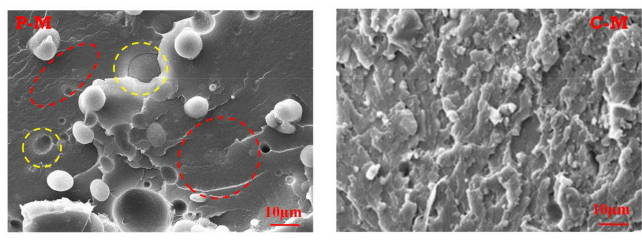PM (physical blend) with LDPE to ABS ratio of 75:25 and CM (chemical blend) with LDPE, ABS to MA ratio of 75:25:5 were prepared by twin-screw extruder. The ABS used was a secondary material treated by physical means for electronic product shells to improve the mechanical properties of PE.

▲ Figure 1 shows the SEM images of PM and CM sections PM (left); CM (right)
PM’s exhibit a clear two-phase, ABS phase dispersed in the PE matrix, the yellow dashed circle shows a clear crater, indicating that ABS and PE debonding occurs under stress, while the red dashed line shows a smooth plane, indicating that there is no distribution of ABS at that location.
This all indicates that the two phases are not well compatible by physical mixing of PM.
PM, on the other hand, is a continuous rough surface, which indicates that ABS is well compatible with PE and can be enhanced.

▲Figure 2 shows the stress-strain curves (a) and Young’s modulus (b) of PE, PM, CM and ABS
Figure 2 shows the stress-strain curves (a) and Young’s modulus plots (b) of PE, PM, CM and ABS to characterize the mechanical properties of the materials.
From Figure 2a, it can be seen that the ultimate fracture strength of CM is significantly greater than that of PM, and the ultimate fracture strength of PM is even lower than that of PE, which is due to the improvement of the ultimate fracture strength of PE by ABS, but the material produces defects due to the poor compatibility of ABS in PM, which reduces the mechanical properties instead.
In contrast, Fig. 2b shows that the Young’s modulus of PE reinforced by ABS is significantly improved, and the improvement of CM is more obvious, which is also in line with the conclusion of SEM plots.











